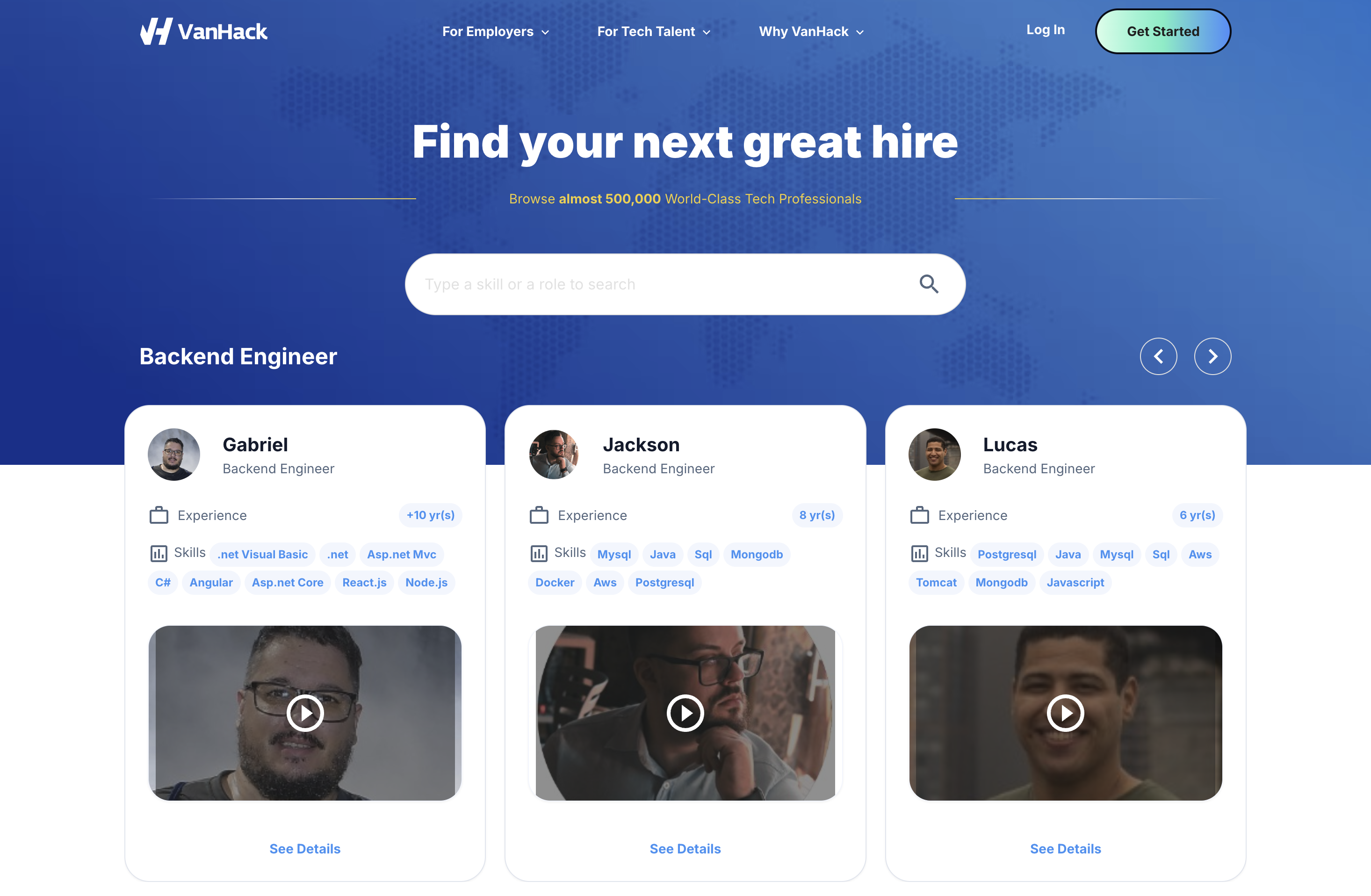Finding skilled Node.js developers can be a challenge for US companies facing a global talent shortage. Latin America offers a strong solution with its pool of capable developers, cost benefits, and cultural fit. This guide walks you through seven practical stages to hire remote Node.js talent from the region, helping you build a solid team while keeping your recruitment process efficient and budget-friendly.
From outlining your ideal candidate to ensuring long-term engagement, each stage includes clear steps and useful tips. Whether you’re a startup or an established business expanding your tech team, these strategies can help you hire effectively. Want to get started? Connect with top talent and speed up your development goals.
Why Choose Latin America for Remote Node.js Developers?
Latin America stands out as a valuable region for US companies looking to hire remote Node.js developers. It combines technical skills, economic advantages, and practical benefits that make remote hiring a smart choice.
One major benefit is cost savings without sacrificing quality. Senior Node.js developers in Latin America earn much less than their US counterparts, with annual salaries averaging $26,000 in Mexico, $28,000 in Brazil, and $24,000 in Argentina, compared to $114,000 or more in the US. This can mean savings of up to 80% on salary costs while still getting skilled professionals.
Cost isn’t the only advantage. Brazil has over 630,000 developers, offering a deep pool of Node.js expertise. Mexico provides close time zone alignment with the US, making collaboration smooth. Argentina brings strong English skills, reducing communication challenges in remote setups.
For hourly rates, remote work with US firms often pays more than local jobs. Senior developers in Latin America charge between $65 and $100 per hour, while remote Node.js developers in Mexico earn from $36,000 to $220,000 yearly, averaging $97,604, showing the higher rates for international roles.
|
Region |
Average Salary Range (USD) |
Key Benefit |
Hourly Rate Range |
|
United States |
$114,000 – $180,000+ |
Local Expertise |
$55 – $90/hr |
|
Mexico |
$26,000 – $97,604 |
Time Zone Alignment |
$45 – $65/hr |
|
Brazil |
$28,000 – $46,000 |
Large Talent Pool |
$40 – $60/hr |
|
Argentina |
$24,000 – $55,000 |
English Proficiency |
$35 – $55/hr |
Time zone overlap is another plus. Mexico and Central America match US business hours, while South American countries are just 1 to 3 hours ahead of EST. This allows for daily check-ins and quick feedback, essential for fast-paced development projects.
Cultural alignment also helps. Many Latin American developers have strong communication skills and a collaborative approach that fits well with US company expectations. Their experience with international teams means they often understand remote work dynamics.
Interested in this talent pool? Begin hiring with VanHack to connect with vetted Node.js developers from Latin America.
7 Essential Stages to Hire a Remote Node.js Developer from Latin America
Stage 1: Outline Your Ideal Node.js Developer and Remote Work Plan
Start by clearly defining the skills and qualities you need in a Node.js developer. Beyond basic JavaScript knowledge, focus on specific expertise in Node.js tools, frameworks, and setups that match your tech stack.
Specify technical needs like experience with Express.js, NestJS, or Fastify, database skills in MongoDB or PostgreSQL, and familiarity with cloud platforms such as AWS or Azure. Also, consider requirements like microservices, Docker, API development, testing tools like Jest, and Git proficiency.
For remote work, soft skills matter just as much. Determine the level of English needed, communication expectations, and familiarity with tools like Jira or Asana. Clarify time zone availability and the ability to self-manage in a distributed team setting.
Create a detailed job description that covers technical skills, remote work requirements, and your company’s culture. Build a scoring system to rank candidates based on skills (40-50%), communication (25-30%), remote experience (15-20%), and cultural fit (10-15%). Document your tech stack and team setup to give candidates a clear picture of the role and expectations.
Stage 2: Source Talent Across Borders with the Right Tools
Finding top Node.js developers in Latin America often means going beyond standard job boards. Many skilled developers aren’t on US-focused sites, so you need to tap into regional networks and communities.
The challenge isn’t just finding candidates, but ensuring their quality. Sorting through applications to assess skills, English ability, and remote readiness requires a targeted approach that generic platforms often lack.
Specialized platforms like VanHack make this easier by connecting you with vetted Latin American talent.

With a database of over 500,000 tech professionals, VanHack uses AI matching to provide a shortlist of 3 to 5 qualified Node.js candidates, cutting down on initial screening time.
If sourcing on your own, explore LinkedIn groups for Latin American developers, GitHub communities, and local tech events with online presence in cities like São Paulo or Mexico City. Partnering with regional recruiters can help, though it may take longer and require more effort to filter candidates.
Stage 3: Set Up Thorough Technical and Communication Checks
Evaluating remote candidates demands a detailed process since you can’t meet in person. For Node.js developers, both coding skills and clear communication across time zones are essential for team success.
Resumes alone don’t show a candidate’s true ability to code or explain ideas. You need assessments that test problem-solving, technical knowledge, and how they work in a remote setting.
VanHack simplifies this with a multi-step vetting system. Video intros let you gauge English skills and personality early on. Coding tests, partnered with platforms like Woven, provide measurable results. AI-driven interviews offer recorded sessions and scores, giving insight into a candidate’s thinking process.
For independent vetting, use tools like HackerRank or CoderPad for coding tests. Include video calls to assess English and cultural fit. Focus interviews on remote work scenarios, asking about self-management and past distributed team experience.
Stage 4: Build a Remote-Friendly Interview Process
Interviewing remote candidates requires adjustments for time zones and cultural differences. Your process should balance thorough evaluation with respect for candidates’ schedules.
Plan a three-step approach. First, a 45 to 60-minute technical screening with coding tasks using tools like CoderPad. Focus on Node.js specifics like asynchronous programming. Second, a 60 to 90-minute session on system design, testing how candidates tackle real challenges and communicate solutions. Third, a 45-minute behavioral interview on remote work habits and alignment with your company’s values.
Use video tools like Zoom with screen-sharing options. Send clear instructions and tech requirements ahead of time. Involve multiple team members to get varied input and reduce bias. Document observations on communication and cultural fit for remote roles.
Stage 5: Craft Offers, Compensation, and Onboarding Plans
Setting pay for Latin American Node.js developers involves understanding local markets and the higher rates for remote US roles. In Mexico, remote salaries range from $36,000 to $220,000 yearly. Senior developers often earn $65 to $100 per hour, with mid-level roles at $35 to $70.
Design offers with competitive base pay, bonuses, and perks like equipment support or learning budgets. Clarify payment terms, often in USD to avoid currency fluctuations, and include work hours and communication expectations.
For onboarding, create welcome kits with company info, tech setup guides, and team intros. Pair new hires with mentors for support. Schedule regular check-ins in the first two months to address issues and set clear performance goals for remote work.
Stage 6: Handle Legal, Compliance, and Payroll Needs
Hiring from Latin America means dealing with local labor laws, taxes, and employment rules. Each country has unique requirements for contracts, benefits, and classifications like employee versus contractor.
Key areas include contract terms, mandatory benefits, tax duties, IP protection, and data security. Errors in worker classification or compliance can lead to penalties, especially with multi-country hires.
VanHack offers support through its Global Mobility services, helping with visas and logistics for hires relocating. Alternatively, Employer of Record services like Remote or Deel can manage payroll and compliance. Consulting local legal and accounting experts also ensures proper setups for contracts and obligations.
Stage 7: Support Integration and Long-Term Retention
Success with remote Latin American developers relies on building a connected team culture across borders. This means intentional efforts in communication and growth opportunities to keep remote staff engaged.
Focus retention on learning and career paths. Offer access to training, certifications, and mentorship. Regular pay reviews tied to experience are vital for keeping top talent. Set clear advancement goals and recognize achievements.
Maintain consistent communication with daily updates, weekly one-on-ones, and async tools for time zone differences. Encourage social ties through virtual events or casual chat channels. Include remote staff in key development practices like code reviews to ensure they feel part of the team.
Ready to build your remote team? Hire efficiently with VanHack and create a strong development unit.
How VanHack Compares to Traditional Hiring Methods
Choosing the right way to hire Node.js developers can impact speed and quality. Specialized platforms like VanHack offer distinct advantages over traditional agencies or job boards.
Agencies often charge 15 to 25% of a hire’s first-year salary, costing $18,000 to $30,000 for a $120,000 role. Job boards like LinkedIn generate many applications but lack vetting, leaving the heavy lifting to you.
VanHack’s subscription, Vanna, costs a flat $3,000 monthly for unlimited hires, making expenses predictable. It includes video intros, coding tests, and AI interviews for detailed candidate insights.
|
Feature |
VanHack |
Traditional Agency |
Job Boards (LinkedIn/Indeed) |
|
Cost Model |
Flat-fee Subscription ($3k/month) |
15-25% success fees ($18-30k per hire) |
Monthly posting fees ($200-500) |
|
Candidate Quality |
Pre-vetted shortlist of 3-5 candidates |
Basic screening, variable quality |
Large volume of unfiltered applications |
|
Technical Assessment |
AI interviews, coding tests, video profiles |
Resume review, basic phone screens |
Self-reported skills only |
|
Time to Shortlist |
2-3 days |
2-3 weeks |
2-4 weeks of manual screening |
VanHack also assists with global mobility, supporting visa and relocation needs for hires, a service not typically offered by agencies or job boards.
Common Questions About Hiring Remote LATAM Node.js Developers
What Are Typical Salaries for Node.js Developers in Latin America Working for US Firms?
Salaries for Node.js developers in Latin America depend on experience, skills, and location. Remote roles with US companies pay more than local rates. In Mexico, annual earnings range from $36,000 to $220,000, averaging $97,604. In Brazil, senior developers earn $31,000 to $46,000 locally, but international roles pay higher. Argentina offers salaries from $24,000 to $55,000 with good English skills. Hourly rates for senior developers are often $65 to $100, providing 30 to 50% savings compared to US rates while maintaining quality.
How Do Time Zones Impact Working with LATAM Node.js Developers?
Time zone alignment is a major benefit of hiring from Latin America. Mexico and Central America share US time zones, allowing for real-time collaboration. South American countries like Brazil and Argentina are just 1 to 3 hours ahead of EST, still offering plenty of overlap for meetings and feedback. This setup reduces delays and supports agile workflows, unlike working with teams in Asia or Europe. Many developers are also willing to adjust schedules for better team coordination.
What Legal and Compliance Issues Should Be Considered for International Hires?
Hiring from Latin America involves navigating local labor laws, tax rules, and employment classifications that differ by country. Key points include contract terms, required benefits, tax withholdings, IP protection, and data security. Misclassifying workers as contractors instead of employees can lead to penalties. Using Employer of Record services or platforms like VanHack can help manage these complexities while focusing on team management.
Can US Companies Hire Node.js Developers Directly from Latin America?
Yes, US companies can hire directly, but it requires attention to local labor laws, taxes, and benefits in the developer’s country. This includes proper contracts, IP protection, and international payment setups. Complexity varies by location, sometimes needing a local presence. Working with legal experts or Employer of Record services simplifies the process. Direct hiring often offers more control and can be cost-effective for long-term team planning.
How Long Does It Take to Hire a Remote Node.js Developer from Latin America?
Hiring timelines vary by approach. With platforms like VanHack, you can get vetted candidates in days. Traditional methods take 4 to 8 weeks, including sourcing and interviews. Independent hiring through job boards may stretch to 6 to 12 weeks due to manual screening. Proper preparation, like clear job specs and legal setups, can shorten the process and improve candidate fit.
Hire Your Next Node.js Developer Quickly with VanHack
Navigating these seven stages to hire remote talent takes effort and planning. VanHack offers a platform tailored for connecting North American companies with Latin American developers. It provides vetted candidates, AI matching, and tools to simplify recruitment.
Their Vanna subscription allows unlimited hiring for a flat $3,000 monthly fee, offering cost clarity for growing teams. VanHack also helps with global mobility, supporting visa and relocation logistics.
Whether you’re hiring one developer or building a team, VanHack equips you to tap into Latin America’s tech talent. Ready to simplify your hiring? Find qualified candidates now with VanHack and start strengthening your remote development team today.



